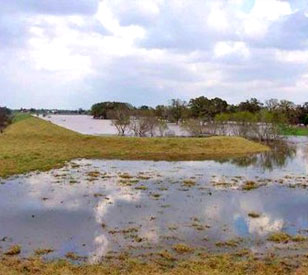Flood Warning Systems

Flood warning systems save lives, protect property and limit damage to infrastructure by monitoring rainfall and water levels and alerting when conditions approach dangerous levels. An effective flood warning system enables authorities to take appropriate action such as evacuation and control of dams in advance of a flood event, often leading to much less catastrophic outcomes when severe weather strikes.
Flood Impacts

Typical Flood Warning System
Effective flood monitoring and risk mitigation is achieved through a network of flood warning stations installed at various points within a watershed or on a body of water. Monitoring stations log both rainfall and water levels and provide advanced warning of dangerous conditions.
The X3 environmental data logger is the central component of NexSens automated flood warning systems. It is compatible with a wide range of sensor types and manufacturers and can transmit real-time data to the WQData LIVE web datacenter via cellular or satellite telemetry. WQData LIVE has a suite of data management tools and alerts via email or SMS text message.
Flexible mounting options for the X3 simplify installation on bridges, dams, piers, levees and other structures. Power is supplied with SP10 solar power packs or connection to mains power.
Sensors typically integrated into NexSens flood warning systems include YSI H-3401 tipping bucket rain gauges and the VEGAPULS C 23 radar level sensor for non-contact level measurement, but nearly all industry-standard weather and level sensors are supported.
Contact a NexSens Applications Engineer today to discuss your flood warning application.

Case Studies
Plum Creek Conservation District Flood Alert System
In an effort to catch and hold floodwaters in the Plum Creek watershed in Lockhart, Texas, a system of lakes, ponds, and spillways was built beginning in the 1950s. The system allows water to be released at a controlled rate, minimizing damage from heavy rains. The Plum Creek Conservation District monitors, maintains, and improves this system to ensure it works properly, maintaining 28 flood control structures and managing underground water resources in parts of both Hays and Caldwell counties.
Read MoreStream Gauging Network
Coal mining can have a number of impacts on the surrounding environment and is therefore one of the most extensively regulated industries in the United States. In 1977, the federal government enacted the Surface Mining Control Reclamation Act in response to the negative land effects of coal mining. Coal producers must go through a complicated process for obtaining local, state, and federal mining permits. SMCRA requires reclamation plans for future coal mining sites; these plans must be approved and permitted by federal or state authorities before mining begins. As of 2003, more than 2 million acres of previously mined lands have been reclaimed in the U.S.
Read MoreReal-Time Rainfall and River Water Quality Data
Located in southwest Ohio, the Edge of Appalachia is the largest privately owned nature preserve in Ohio and provides critical habitat for rare species of plants and animals. Ohio Brush Creek, a tributary of the Ohio River, runs through the preserve and is home to several species of endangered freshwater mussels. To document long-term trends in water quality and rainfall on the preserve, a monitoring system was installed that allows real-time collection of data. This real-time connection, supported by NexSens data loggers and software, allows the preserve to “take the pulse” of the creek for the benefit of students, visitors, and researchers.
Read More







